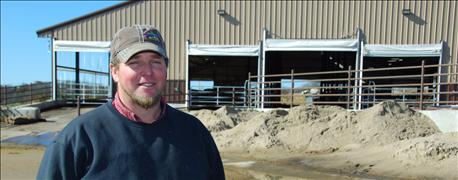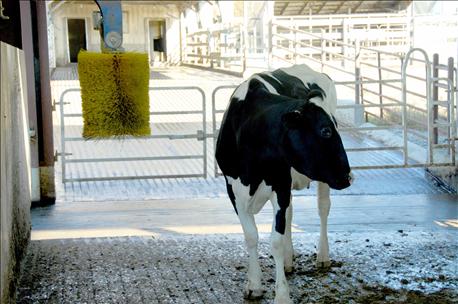June 7, 2016

Polk County dairy farmer Nelson Hostetler can think of a ton of reasons to like his new confined dairy shed and animal waste system. The most obvious reasons are documented in Hostetler's daily production log. It shows that the 100 cows that formerly resided in a couple of pastures are producing about 2,000 more pounds of milk each day since they were brought inside less than a year ago.
"We're right at 20 pounds more per cow today than we were a year ago," Hostetler says. "When we built this, we said we had to get six more pounds (for the investment to pay). I expected it to work well, but it's working better than I expected."

MORE MILK: Nelson Hostetler found that bringing his dairy cows off pasture increased his milk production. He was also able to increase his dairy herd size by 25% now milking 125 cows without additional labor costs.
What Hostetler built on his dairy farm, with design and financial assistance from the USDA Natural Resources Conservation Service, is a completely covered structure in which the cows rest in stalls bedded with a thick layer of sand.
The building
The covered structure has curtains that can be opened or closed depending on the outside temperature. When the cows want to eat or drink, they leave their stalls and walk across concrete alleys to get to the food and water. It's also a short walk to the milking barn.
The shed includes some cow-friendly amenities, such as a spinning brush that cows can activate to brush off dead hair and stimulate new hair growth. While the cows seem content to eat, drink and lie in the stalls when they are not being milked, Hostetler has plans to build some adjacent exercise pens to allow the cows to go outside when the weather is nice.
The benefits

BACK RUB: Amenities like a spinning brush allow cows adds to cow comfort.
Hostetler says that not only is each cow producing more milk, but he also has been able to increase his herd size by 25%, from milking 100 cows to about 125 cows per day, without increasing his labor.
Hostetler points to one reason for this increased production. "Cow comfort," he says. "If it rains or snows out there, these cows can just lie in here in the sand and they don't need to try to find a tree to lie under. The cows can eat, lie down and rest a few hours and then get up and get some more to eat and drink."
Hostetler says he has also noticed fewer health issues with his cows because the flushed alleys keep them cleaner than when they stood in waste in the feeding area.
"The condition of the cows is better than it's ever been with this much milk," he says.
Rahm is a public affairs officer for USDA NRCS in Columbia.
You May Also Like




